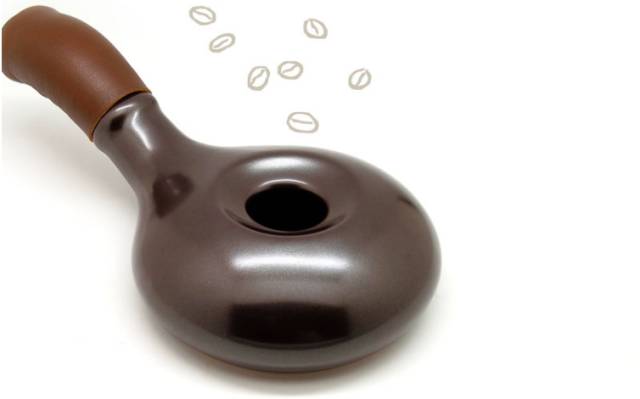How much do you know about the sour and bitter of coffee?
Follow the caf é (Wechat official account vdailycom) and found that Beautiful Cafe opened a small shop of its own.
Where does the bitter coffee come from?
In order to solve this mystery that has plagued us for many years, Thomas Hofmann, a German scientist, has conducted an in-depth study of the bitterness of coffee.
He filtered the brewed coffee and conducted a series of experiments to determine that the molecule, chlorogenic acid lactone, was the culprit. (for convenience, let's call it Little Green.) so small green has been around since the beginning of raw beans?
To explain what small green is, we must first talk about its source: chlorogenic acid.
To put it simply, chlorogenic acid exists in most plants and is produced by plants in the process of aerobic respiration. The small green is the coffee beans in the roasting process, decomposed from chlorogenic acid.
During the roasting process of coffee beans, the small green will increase with the deepening of the roasting degree. In light and moderate roasting, Little Green will only produce mild bitterness, which is what we call coffee characteristic, pleasant bitterness.
As the baking time increases, the small green will be decomposed again and replaced by vinyl catechol polymer, which is the source of strong bitterness.
In this way, it is not difficult for us to understand why there is a saying in the world of curry-shallow sour, deep bitter. What we call pleasant bitterness is chlorogenic acid, and unpleasant bitterness is vinyl catechol polymer.

Where does the sour coffee come from?
The sour ingredients in raw coffee beans are citric acid, malic acid, quinic acid, phosphoric acid and so on, but this is not the sour taste we feel when we drink coffee. The sour taste we taste mainly comes from the acid produced in the baking process.
When roasting coffee beans, some of the ingredients in the beans will undergo chemical changes to form new acids. For example, chlorogenic acid decomposes after heating to form quinic acid, and sugars decompose to form volatile formic acid and acetic acid.
Most people mistakenly think that coffee is sour if it is not fresh, and sour coffee is not good. This is really a great smear and misunderstanding!
The more fastidious people, and the more people who study the taste of coffee, tend to pay more attention to the sour coffee. In fact, all kinds of coffee, no matter what kind of coffee, when you roast deep enough, can get a very similar scorched aroma, drink similar bitterness, but the sour taste is not so easy to do.
Coffee itself is an acidic drink, whether coffee is sour or not mainly depends on the degree of roasting of beans:
The longer the baking time, the higher the degree of caramelization, and the more acid is destroyed, the less likely it is to taste sour.
The shorter the baking time, the lower the degree of caramelization, the less acid damage, and it is easy to make sour coffee.
In other words, the degree of roasting is inversely proportional to the sour taste, the deeper the coffee is, the less sour the coffee is, and the more sour the beans are.
I am afraid that the sour people had better finish the coffee while it is hot, otherwise the sour taste of the coffee will appear as the temperature drops.
Is coffee good or bad determined by sour and bitter taste?
A cup of coffee is a complex drink made up of more than 30 chemicals, and it is these "compounds" that determine the taste, aroma and acidity of coffee.
It is not that the bitterness caused by deep baking is bad, but that each type of coffee bean has its own roasting degree. According to the characteristics of each coffee bean, the roaster will choose the most suitable baking degree according to the characteristics of each coffee bean, and perfectly show the unique flavor of each coffee bean.
The preference of coffee roasting degree from country to country often varies from region to region. In principle:
The baking in Italy is getting deeper and deeper from north to south:
Milan, north of Italy, is medium-baked and the coffee is slightly sour.
In contrast, Rome in the south is heavy-roasted, and the coffee has no sour taste.
Coffee roasting in the United States is getting shallower from west to east:
The baking degree in West Bank cities such as San Francisco and Seattle is deeper than that in New York or Washington.
The coffee on the west coast is darker than that on the east coast, and it tastes more sweet and bitter.
The east coast prefers a more lively sour taste, mostly medium-deep baking or light baking.
Caffeic acid is not a criterion for judging whether the quality is good or bad or whether it is fresh or not. it is all a matter of subjective taste. If you are afraid of acid, you will choose deep baked beans or Asian beans, and if you are acidophilic, you will drink shallow baked beans or African beans.
There is no denying that there are far more consumers who prefer deep-roasted coffee than light-roasted coffee. The fine coffee revolution in the United States over the past two decades has also taken medium-and deep-roasted coffee as the mainstream, choosing extremely hard beans above 4,000 feet above sea level as the main formula.
The unique aroma and sweetness of deep baked beans are highlighted by re-baking. If you add milk seasoning, it is easier to bring out chocolate flavor.
Shallow roasted coffee is a little aggrieved in the torrent of deep roasted beans, but the unique lively and clear flavor of shallow roasted beans can not be replaced by deep roasted beans.
In addition, the consumption rate and fuel cost of shallow baked beans are lower than those of baked beans, which is one of the magic weapons for large baking factories to survive the recession, so shallow baked beans can not disappear in the market.
Like sour coffee with rich taste changes, you might as well buy light-roasted African beans and Central American beans, such as Kenya, Ethiopia, Yemen mocha, Guatemala, Costa Rica, etc., are good sour beans.
Consumers who prefer strong, sweet coffee can choose Asian deep-baked beans or aged beans, such as Mantenin in Indonesia, Java, Indian beans and Brazil in South America.
It should be emphasized here that although the sour taste of Asian beans is low, they will still taste sour if they are roasted shallowly, but the Asian beans are not lively enough and feel a little sour, which is far less varied than shallow baked beans in Africa or Central America.
But everyone's preferences are different, some people like to play with this acid, some people hate to drink sour taste, and most people do not like to drink sour taste, so the general coffee shop will show a weaker sour coffee.
In order to reduce the sour taste, the coffee beans will bake deeper, seriously, it is a pity to erase the beautiful flavor of the coffee, and in order to take into account the taste of the public, it is not easy for people who really want to taste the coffee to have a good taste of the coffee.
Coffee fans had better open their minds and come into contact with coffee of different roasting degrees and places of origin, so that they can understand the fun of playing coffee.
Important Notice :
前街咖啡 FrontStreet Coffee has moved to new addredd:
FrontStreet Coffee Address: 315,Donghua East Road,GuangZhou
Tel:020 38364473
- Prev

Introduction of coffee roasting utensils in the kitchen
There is a kind of baking called hand net baking. The appliance is simple, and the operation process is not complicated, which can be done with a baking hand net and a gas stove. You can bake your own coffee beans in the home kitchen, control the roasting degree of the coffee, smell the slowly escaping aroma of the coffee, and hear the crackling sound of the coffee beans. Today we will introduce two kinds of baking for you.
- Next

Rumor: drinking instant coffee is more carcinogenic than smoking?
In early May, an article entitled "do not drink instant coffee, carcinogens are more than smoking" began to spread on major websites across the country, saying that the concentration of acrylamide, a carcinogen detected in instant coffee, was higher than that of potato chips, French fries, cakes and cigarettes, and the harm of drinking instant coffee.
Related
- Beginners will see the "Coffee pull flower" guide!
- What is the difference between ice blog purified milk and ordinary milk coffee?
- Why is the Philippines the largest producer of crops in Liberia?
- For coffee extraction, should the fine powder be retained?
- How does extracted espresso fill pressed powder? How much strength does it take to press the powder?
- How to make jasmine cold extract coffee? Is the jasmine + latte good?
- Will this little toy really make the coffee taste better? How does Lily Drip affect coffee extraction?
- Will the action of slapping the filter cup also affect coffee extraction?
- What's the difference between powder-to-water ratio and powder-to-liquid ratio?
- What is the Ethiopian local species? What does it have to do with Heirloom native species?

